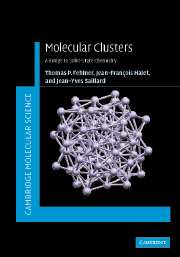Book contents
- Frontmatter
- Contents
- Preface
- 1 Introduction
- 2 Main-group clusters: geometric and electronic structure
- 3 Transition-metal clusters: geometric and electronic structure
- 4 Isolobal relationships between main-group and transition-metal fragments. Connections to organometallic chemistry
- 5 Main-group–transition-metal clusters
- 6 Transition to the solid state
- 7 From molecules to extended solids
- 8 Inter-conversion of clusters and solid-state materials
- Appendix: Fundamental concepts: a concise review
- Problem Answers
- References
- Index
8 - Inter-conversion of clusters and solid-state materials
Published online by Cambridge University Press: 19 February 2010
- Frontmatter
- Contents
- Preface
- 1 Introduction
- 2 Main-group clusters: geometric and electronic structure
- 3 Transition-metal clusters: geometric and electronic structure
- 4 Isolobal relationships between main-group and transition-metal fragments. Connections to organometallic chemistry
- 5 Main-group–transition-metal clusters
- 6 Transition to the solid state
- 7 From molecules to extended solids
- 8 Inter-conversion of clusters and solid-state materials
- Appendix: Fundamental concepts: a concise review
- Problem Answers
- References
- Index
Summary
The conceptual connection between cluster and solid-state chemistries is the unifying theme of the first seven chapters. Complementary empirical connections between cluster and solid-state chemistries are emphasized in this final chapter. That is, the synthesis of solid-state materials from molecular precursors including clusters permits the strengths of molecular synthesis to be used in the development of new materials. On the other hand, the utilization of Zintl clusters as novel reagents in solution permits the advantages of thermodynamically driven solid-state synthesis to be transferred to the production of clusters in solution. Most of the examples discussed could have been included in earlier chapters, but are gathered here to serve as a review as well as a stimulus to creative thought for future research in cluster and materials chemistries.
Cluster precursors to new solid-state phases
In this section we give examples of molecular clusters used as precursors to new dense phases or to new porous networks.
III/VI Semiconductor synthesis
Traditional solid-state syntheses at high temperatures are guided by thermodynamics expressed in phase diagrams in distinct contrast to much of molecular chemistry that utilizes kinetics to guide synthesis. We viewed clusters as fragments of bulk solids stabilized by ligands; however, not all clusters can be viewed as building blocks of known bulk structures, e.g., icosahedral clusters. Hence, metastable phases not accessible by conventional solid-state synthesis might arise from cluster precursors. In other words, the structure of a cluster building block could determine the nature of the first-formed solid phase.
- Type
- Chapter
- Information
- Molecular ClustersA Bridge to Solid-State Chemistry, pp. 303 - 322Publisher: Cambridge University PressPrint publication year: 2007



